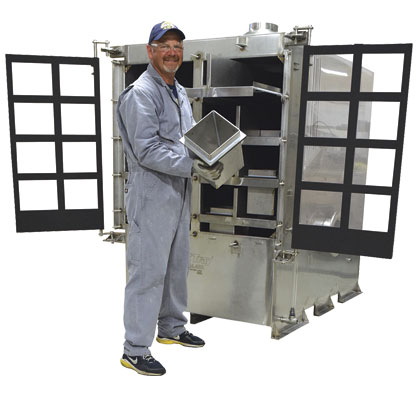Chlorine is most frequently used to disinfect drinking water, and existing regulations both limit THMs at the point of end use and require a “residual disinfection level,” or enough disinfectant to last through the entire system to the end point of use. The catch-22 is that residual disinfection can lead to the generation of additional DBPs even after final water treatment if precursor organics are still present. As a result, water treatment facilities must reduce the level of THMs enough so that any generated by residual disinfection do not push the final total over the regulatory limit. Air strippers can efficiently and effectively remove THMs to far below regulatory limits, thereby leaving enough “breathing room” for the generation of more THMs caused by disinfection during the water’s path through pipes to its end use point.
Another pressing issue in drinking water treatment currently, given nationwide news about lead and copper levels exceeding standards, is ensuring that the pH of water is within reasonable limits. Water, usually groundwater, with too much dissolved CO2 can be aggressive and therefore dissolve protective coatings on pipes and also dissolve the pipes themselves, leading to excess levels of lead and copper. By stripping the excess CO2 out of the water, plants can effectively increase pH and decrease levels of lead and copper at the point of end use.
EXAMPLES OF AIR STRIPPING IN ACTION
QED’s sliding tray air stripper, the E-Z Tray, was the first self-contained air stripper to achieve certification from NSF International to NSF/ANSI Standard 61: Drinking Water System Components – Health Effects. This particular design of air stripper has been employed in a variety of drinking water treatment facilities to address the issues described above at a low cost and with minimal impact to the facilities.
One such example is the U.S. Army Corps of Engineers–Omaha District-funded design and construction of a new groundwater treatment plant in Cheyenne, Wyoming. This plant was designed to treat groundwater from the city’s Borie well field, an important groundwater supply that was contaminated with a chlorinated VOC in the late 1960s at the former F.E. Warren Atlas Missile Site 4. In this application, a total of four, six-level tray QED E-Z Trays, each with a treatment capacity of 1,000 gallons per minute, were used in the plant design to ensure that the TCE treatment goal of less than non-detection could be reached. The E-Z Tray units chosen for the Cheyenne treatment facility have more than enough capacity to handle the city water’s contamination load, with capacity to spare should any changes to the water’s contamination levels occur, and the plant operators have encountered no issues so far.
Another successful implementation of the E-Z Tray air strippers is in place at the Cedarburg, Wisconsin Light and Water Utility water treatment plant. The Cedarburg Water Utility installed a QED E-Z Tray Air Stripper to their existing production pump building. The E-Z Tray 72.6 handles a flow rate of 600 gallons per minute and treats groundwater containing a chlorinated VOC traced back to a nearby landfill. The air stripper is meeting the goal of complete removal.
Cedarburg had been using a packed tower air stripper for eighteen years to treat TCE at a different supply well location, but when the new contamination needed to be addressed, the plant operators began researching alternatives, as they had encountered issues with the tower at the other location. In addition, the plant in question is adjacent to a residential neighborhood and so the aesthetics of a tower would have been an issue. The E-Z Tray system was not only competitively priced and offered simpler maintenance, it also could be discreetly housed indoors.
Finally, QED supplied an E-Z Tray system to the City of Santa Cruz, California, for THM reduction in groundwater that had been partially recharged with treated, reused wastewater. The system was installed in late 2015 and has resulted in consistent THM reductions of 78 to 98 percent, with the system’s treatment cost per gallon far lower than alternative methods.
SUMMARY
Air stripping technology has proven to be an effective process not just for groundwater remediation, as it has been used in the past, but also for the treatment of both groundwater and surface water sources of drinking water. Air stripping effectively removes VOCs, including DBPs such as THMs from chlorine disinfection, and dissolved gases like CO2 in the case of overly acidic water sources. In doing so, it reduces treatment costs over competing treatment options and ensures adherence to regulations. It is therefore an ideal treatment option for these sources of contamination in small and medium-sized drinking water treatment plants.
About the author:
Dave Fischer is vice president of technology and product manager for treatment equipment for QED Environmental Systems, Inc. QED Environmental Systems is the leading manufacturer of innovative environmental products. For over thirty years their expertise has included pumping systems, landfill products, and air strippers. For more information, visit www.qedenv.com.
_______________________________________________________
MODERN PUMPING TODAY, May 2018
Did you enjoy this article?
Subscribe to the FREE Digital Edition of Modern Pumping Today Magazine!
![]()


